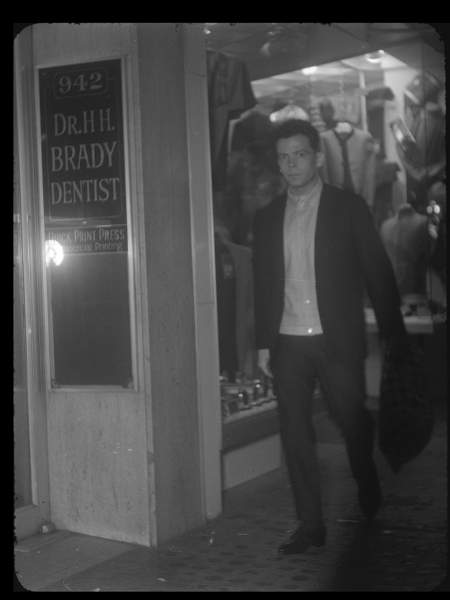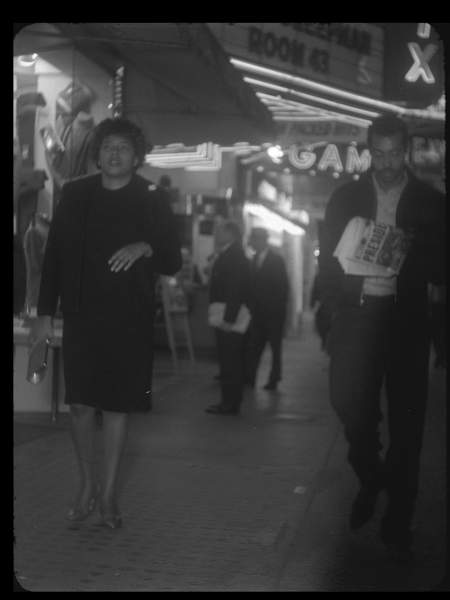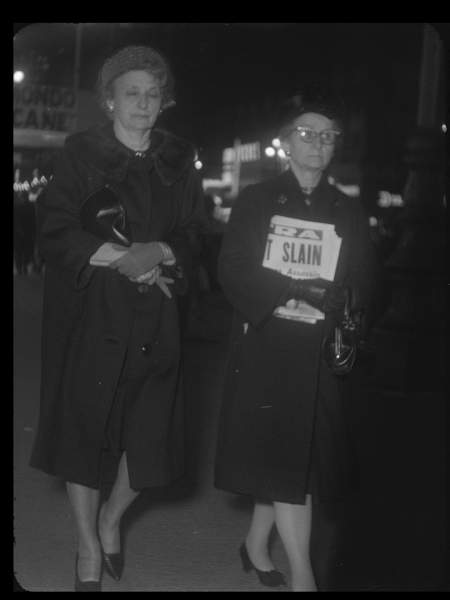Introduction
to Roll H - The "Night" roll
Home
There
is very little anecdotal record of Selle's working methods. No one alive today seems to have known
him. Only two brief articles from San
Francisco newspapers in 1966, and near the time of his retirement in 1974, so
much as hint at the details of his operation.
All conclusions have been reached by close examination of the
substantial archive of film rolls, the sequences of frames, and the content of
individual frames.
Among
the first 12 rolls of negatives from the Fox Movie Flash archive to be
digitally scanned, this one differs from the others, having been shot entirely
at night. Selle's daytime photography
exhibits a high degree of consistency.
He tends to shoot from the same locations day after day, generally
capturing the same clientelle of potential buyers - downtown shoppers and tourists - bums not
welcome.
Photographing
at night, he is even more systematic. The Dupont film emulsion may have provided the greater 'speed' he required for night-time shooting. This might explain why the night shooting is segregated from his daytime work most of which
is shot on Ansco Supreme. Evidence of his use of flash bulbs appears in occasional reflections of the building directory at 942 Market St. which just happens to be the building in which the Fox Movie Flash office is located!
In other words, Selle's night time work takes place on the sidewalk right outside his building. Might this be in part because he's burdened by needing to carry and dispose of flash bulbs?


Despite Selle's limited mobility going out each evening with four to five dozen flash bulbs, this roll includes many clues which provide useful insights to his strategy and schedule.
At first glance, there appear to be 'bad' or blank frames which one might be tempted to discard. Closer examination, however, suggests that Selle must have purposely aimed his camera down at the
sidewalk (occasionally capturing his shoe). That one or more of these 'bad' frames always coincides with changes of programs at the Pix suggests that Selle either began or finished his evening's photography by wasting a frame for 'benchmarking' purposes.
The marquee
of the Pix Theatre at 938 Market St. appears in the backgrounds of 100s of these frames. No longer in operation, the Pix was known as a 'grind' house changing it triple bill as often as 3 times each week.
The pattern may have been: one program Saturday/Sunday/Monday; another program Tuesday/Wednesday; the third program Thursday/Friday.
Close examination of the Pix marquees reveals the program changes
every 50-100 frames. The triple bills usually include one Western, one "thriller" (crime, mystery, or adventure), and one "female feature" (aka titilating per 1960s standards).
Science fiction programs often bunched together 3 sci-fi/horror films on a single bill (for example: Triffids, Blood, Petrified World).
Unfortunately, the Pix, as a 'grind' house did not advertise its programs in newspapers. No formal records have been found to match their programming to specific dates.
However, San Francisco film buff and historian Jack Tillmany attended many downtown programs in this era and has kept a life-long diary which includes dates, theatres, and titles.
Tillmany's diary records his seeing the Sheepman at the Pix on November 25, 1963, and on December 23 he returned to see One Foot in Hell and Police Nurse.
Between these two 'benchmark' dates, we can count 12 program changes on the Pix marquees (see chronology below).
Lacking records of the Pix's programs, an alternate benchmark turns out to be the marquee of the Esquire just a couple doors beyond the Pix, and only occasionally visible in this roll. However, the dates for Mondo Cane followed by L Shaped Room at the Esquire can be determined. Mondo Cane played from November 6-26, 1963; L Shaped Room probably played the next 2-3 weeks. On this basis, we can conclude that this roll spans about 6 weeks and that Selle went
out about five nights each week often exposing as few as 50 frames which is far
fewer than his daytime rate. Jack Tillmany's record of seeing The Sheepman at the Pix on November 26 doesn't necessarily mean that Selle was working that night. Indeed, the program including The Sheepman may have run from November 23-25 which would explain the 5 images of people carrying EXTRA editions of newspapers bearing the "President Slain" headline the day after the assassination of President Kennedy on November 22. The 87 frames Selle shot during the run of The Sheepman may represent two night's work, the first of which appears to have been November 23.
The impact of the tragedy can almost be discerned in the faces of the people he photographed during this period. References: "The
Last of the City's Street Photographers" San Francisco Examiner. January 23, 1966. "Sidewalk
Shutter Slows Down" San Francisco Chronicle. December 30, 1974. Tillmany, Jack. e-mail correspondence with Eskind. November, December 2003; January 2004. For insights and assistance, I wish to thank: Jenni Olson, John Rice, Jack Tillmany. Pix
Program A (Nov 19-20) begins 11-521; ends 11-559 = 38 frames Swordsman of Siena
(1962) Westbound
(1959) Trouble
in the Sky (1960) Esquire Program: Mondo
Cane (1962) Pix
Program B (Nov 21-22) begins 11-561; ends 11-661 = 101 frames (probably photographed on 2 evenings: see 11-590) Gunfight at the OK Corral (1957) Key
Witness (1960) Overnight
Girl (1952) Esquire Program: Mondo
Cane (1962) Pix
Program C (Nov 23-25) begins 11-663; ends 11-750 = 87 frames (possibly photographed on 2 evenings: see 11-725) The
List of Adrian Messenger (1963) The
Sheepman (1958) - Jack Tillmany saw this at Pix Nov 25 - frame 11-674 Room 43
(1959) - frame 11-669 Esquire Program: Mondo
Cane (1962) Pix
Program D (Nov 26-27) begins 11-752; ends 11-861 = 111 frames (probably photographed on 2 evenings: see 11-803) Saddle
the Wind (1958) - frame 11-759 The Vanishing Gangsters (re-make 1952)- frame 11-854 Legion of the Doomed (1958) - frame 11-754 Esquire Program: Mondo
Cane (1962) - ends at frame 11-802 - November 26 (per end of Mondo Cane run) Esquire Program: L
Shaped Room - begins frame 11-805; continues midway thru 12-380 Pix
Program E (Nov 28-29) begins frame 11-864; ends 11-968 = 104 frames (possibly photographed on 2 evenings: see 11-933 or 11-935) Fort
Dobbs (1958) Carnival
Story (1954)
Affair
in Havana (1957) - frame 11-867 Pix
Program F (Nov 30, Dec 1-2) begins frame 11-970; ends 12-037 = 67 frames (probably photographed on 2 evenings: see 11-994) Seven Seas to
Calais (1962) - frame 11-996 Canyon
River (1956) - frame 11-972 Nightfall Pix
Program G (Dec 3-4) begins frame 12-039; ends 12-124 = 96 frames (probably photographed on 2 evenings: see 12-074) Last
Voyage (1960) - frame 12-0051 Ring of
Fire (1961) - frame 12-043 Gunsmoke
at Tucson - frame 12-043 Pix
Program H (Dec 5-6) begins 12-126; ends 12-280 = 154 frames (probably photographed on 2 evenings: see 12-204) Day of
the Triffids (1963) - frame 12-136 also 12-185 Corridors
of Blood (1958) - frame 12-132 Incredible Petrified
World (1958) Pix
Program I (Dec 7-9) begins 12-282; ends 12-381 = 100 frames (probably photographed on 2 evenings: see 12-340) Young
and the Brave (1963) - frame 12-286 Bonnie
Parker Story (1958) Naked
Hills (1956/1957) - frame 12-284 Pix
Program J (Dec 10-11) begins 12-391; ends 12-480 = 90 frames (probably photographed on 2 evenings: see 12-430) Drums
of Africa (1963) - frame 12-460 Plunderers Pearl
of the South Pacific (1955) - frame
12-403 Pix
Program K (Dec 12-13) begins 12-484; ends 12-542 = 57 frames Escape from East Berlin (1962) Cannibal
Attack Cry
Vengeance Pix
Program L (Dec 14-16) begins 12-545; ends 12-592 = 47 frames Cattle
King (1963) Ski
Troop Attack - frame 12-554 Hell is
a City - frame 12-554 Pix
Program M (Dec 17-18) begins 12-595; ends 12-649 = 54 frames Colorado (1963) - frame 12-596 Cairo Last Woman
on Earth Pix
Program N (Dec 19-20) begins 12-651; ends 12-716 = 65 frames Torpedo
Run (1958) East of
Kilimanjaro Flesh
and the Spur (1956) - frame 12-678 Pix
Program O (Dec 21-23) begins 12-718; ends 12-807 = 89 frames (probably photographed on 2 evenings: see 12-764) - December 23 (per Tillmany diary) The
Stripper (1963) One
Foot in Hell Police
Nurse Pix
Program P (Dec 24-25) begins 12-809; ends 12-847 = 38 frames
(colder, pre-Christmas?) Yellow Canary Young
Guns Pirates
of Tortuga Pix
Program Q (Dec 26-27) begins 12-849; ends 12-1001
plus 13-003 = 152 frames (probably photographed on 3 evenings: see 12-896, 12-948) The Law
& Jake Wade (1958) Seven Women
from Hell Squad
Car Pix
Program R (Dec 28-30) begins 13-006; ends 13-057 = 53 frames Battle
at Bloody Beach (1961) The
Lion Flaming
Frontier


"President Slain" newspaper #1, November 23.
"President Slain" newspaper #2, November 23.
"President Slain" newspaper #3, November 23.
"President Slain" newspaper #4, November 23.
"President Slain" newspaper #5, November 23.
** The dates assigned to each program are extrapolations from Jack Tillmany's diary entries for November 25 and December 23. Although this appears to be a perfect
fit, it is based on 2 assumptions: 1) Pix programming followed a regular 3-change-per-week pattern of Sat/Sun/Mon; Tue/Wed; Thur/Fri (including Christmas week); 2) Selle photographed every program (never missed 2 nights in a row owing to weather, illness, vacation, etc).